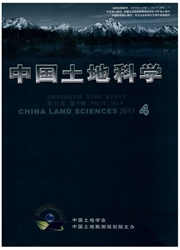

 中文摘要:
中文摘要:
研究目的:在全面分析国土空间承载效率、国土开发支持能力及其匹配关系的基础上,考察北京市国土开发强度时空分异规律,揭示北京市国土开发过程中存在的问题及未来发展趋势,提出未来国土开发利用的建议。研究方法:依据全国主体功能区规划对国土开发强度概念的界定,综合运用GIS空间分析和数理统计方法对国土开发强度进行分析评价。研究结果:北京市国土开发强度具有大都市共性,开发强度较大,分布呈现出明显的圈层结构,并存在与自然本底条件、城市化进程、首都功能不匹配等问题。研究结论:北京未来应充分考虑首都国土空间独有的战略价值,根据自然条件适宜性以及资源环境承载能力进行国土开发,严格控制围土开发强度;同时,对不同的发展区域应采取差别化的国土开发和空间结构重组策略,促进区域空间秩序的协调。
 英文摘要:
英文摘要:
The purpose of this paper is to examine the temporal and spatial differentiation tendencies of land development intensity in Beijing based on the analysis of carrying-capacity efficiency, the development-supporting capacity, and their matching degree. It thus can reveal the problems and future development trends of land development in Beijing and provide policy recommendations for the future. GIS spatial analysis and mathematical statistics were combined to analyze and evaluate the land development intensity based on the definition of intensity in the major functional land zoning. The results of the paper show that land development intensity in Beijing presents the common features of metropolis development, i.e., high development intensity and distinct circular layer structure of spatial distribution. Furthermore, the land development intensity of Beijing shows disequilibrium in terms of natural embeddings, urbanization progress and function of the Capital of China. The conclusion of this paper is that Beijing should fully recognize the unique strategic value of its land in the future, strictly control the land development intensity, and meanwhile adopt specific land development and spatial structure readjustment strategies in different areas, regarding the local specific suitability of natural condition and the specific carrying capacities of environment and resource, and promote the coordination of regional spatial orders.
 同期刊论文项目
同期刊论文项目
 同项目期刊论文
同项目期刊论文
 期刊信息
期刊信息
